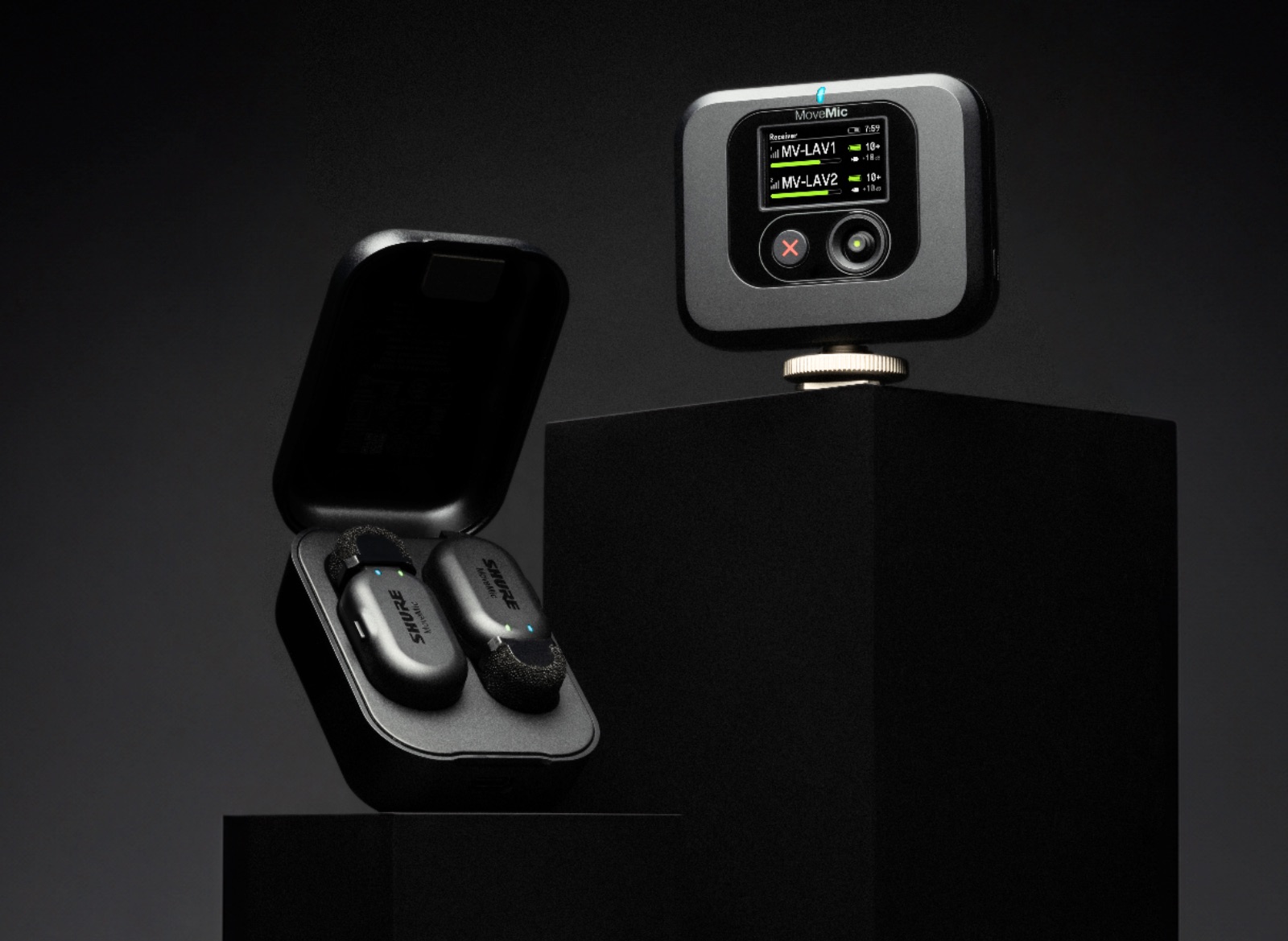In today’s fast-paced world, earbuds have become an indispensable part of our daily lives. Whether we’re commuting on a crowded train, sweating it out at the gym, or just relaxing at home with our favorite podcast, these little marvels of technology keep us connected to our audio world. But have you ever paused to wonder how something so small can capture your voice so clearly? How can these tiny devices pick up your whispers and transmit them across the globe? Let’s embark on a fascinating journey to uncover the intricate world of earbud microphones!
Picture this: You’re on a video call with your best friend, sharing the latest gossip while strolling through a bustling park. Despite the cacophony of children playing, dogs barking, and the general hubbub of urban life, your friend can hear every word you say as if you were standing right next to them. It’s almost like magic, isn’t it? But as Arthur C. Clarke famously said, “Any sufficiently advanced technology is indistinguishable from magic.” And that’s exactly what we’re dealing with here – advanced technology packed into a tiny package.
The evolution of earbud technology has been nothing short of remarkable. Cast your mind back to the early days of personal audio. Remember those bulky headphones that made you look like you were about to land a plane? Or the first generation of earbuds that came with your MP3 player – the ones that were about as comfortable as shoving pebbles in your ears? We’ve come a long way since then.
Today’s earbuds are marvels of engineering. They’re wireless, comfortable, and packed with features that would have seemed like science fiction just a decade ago. Active noise cancellation, touch controls, voice assistants – the list goes on. But at the heart of this evolution is the microphone technology that allows us to not just listen, but also communicate effortlessly.
The microphone in your earbuds is like a tiny ear that’s always listening. It’s ready to pick up your voice, whether you’re making a call, recording a voice memo, or asking Siri for the weather forecast. But how does something so small work so effectively? That’s what we’re here to explore.
In this article, we’re going to take a deep dive into the world of earbud microphones. We’ll unravel the mysteries of how these tiny tech marvels capture your voice, convert it into electrical signals, and transmit it to your devices. We’ll explore the different types of microphones used in earbuds, the challenges engineers face in designing them, and the cutting-edge technologies that are pushing the boundaries of what’s possible.
So, whether you’re a tech enthusiast, a curious consumer, or just someone who wants to understand the gadgets they use every day a little better, buckle up! We’re about to embark on a journey into the microscopic world of earbud microphones. By the end of this article, you’ll never look at (or listen through) your earbuds the same way again.
II. Understanding Microphone Basics
Before we dive into the nitty-gritty of earbud microphones, let’s start with the basics. After all, you can’t appreciate the complexity of a symphony without understanding individual notes, right?
What is a microphone?
At its core, a microphone is a device that converts sound waves into electrical signals. It’s like a translator, taking the language of sound and turning it into something electronic devices can understand. In the case of earbuds, these electrical signals are then processed and transmitted to your phone or other connected devices.
But what exactly is sound? Sound is essentially vibrations traveling through a medium (usually air). When you speak, sing, or make any noise, you’re creating disturbances in the air around you. These disturbances travel as waves, much like ripples on a pond when you throw a stone in.
A microphone’s job is to detect these vibrations and convert them into an electrical signal that mirrors the original sound. It’s a bit like how our ears work – they detect sound waves and convert them into signals our brain can understand. In fact, microphones are often called “electric ears”!
Types of microphones used in earbuds
When it comes to earbuds, two types of microphones reign supreme:
- MEMS (Micro-Electro-Mechanical Systems) microphones: These tiny marvels are the most common type found in modern earbuds. MEMS microphones are incredibly small, energy-efficient, and offer excellent sound quality. They’re not just used in earbuds – you’ll find them in smartphones, laptops, and even some hearing aids.
- Condenser microphones: While less common in earbuds, some high-end models use miniature condenser microphones. These are known for their sensitivity and ability to capture a wide range of frequencies. They’re the go-to choice for professional audio recording, but miniaturized versions have found their way into some premium earbuds.
Let’s break down the differences:
| Feature | MEMS Microphones | Condenser Microphones |
|---|---|---|
| Size | Extremely small (< 1mm) | Slightly larger |
| Power consumption | Very low | Higher |
| Sensitivity | Good | Excellent |
| Cost | Lower | Higher |
| Durability | Highly durable | More delicate |
| Frequency response | Good | Excellent |
| Manufacturing process | Silicon-based | Traditional assembly |
As you can see, MEMS microphones are the go-to choice for most earbud manufacturers due to their compact size and efficiency. But why are they so popular? Let’s dive a little deeper.
The MEMS Microphone Revolution
MEMS microphones have revolutionized the world of portable audio devices. Their development is a testament to the incredible advancements in microelectronics and microfabrication techniques.
The key advantage of MEMS microphones is their size. Traditional microphones rely on relatively large diaphragms and complex assemblies. MEMS microphones, on the other hand, are fabricated on silicon wafers using techniques similar to those used in computer chip production. This allows for incredibly small sizes – we’re talking about microphones smaller than a grain of sand!
But it’s not just about size. MEMS microphones offer several other advantages:
- Consistency: Because they’re manufactured using precision semiconductor processes, MEMS microphones are incredibly consistent. This means that the microphone in your left earbud will perform almost identically to the one in your right earbud.
- Durability: MEMS microphones are solid-state devices with very few moving parts. This makes them resistant to shock, vibration, and temperature changes – perfect for devices that might get dropped or exposed to various environments.
- Low power consumption: In the world of portable devices, battery life is king. MEMS microphones sip power, helping your earbuds last longer between charges.
- Digital output: Many MEMS microphones can output digital signals directly, simplifying the audio processing chain in digital devices.
Condenser Microphones: The High-Fidelity Option

While MEMS microphones dominate the earbud market, some high-end models opt for miniature condenser microphones. But what makes condenser microphones special?
Condenser microphones are renowned for their excellent frequency response and sensitivity. They can capture subtle nuances in sound that other microphone types might miss. This is why they’re the preferred choice in professional recording studios.
A condenser microphone works by using a thin, electrically charged diaphragm suspended close to a metal plate (called a backplate). When sound waves hit the diaphragm, it vibrates, changing the capacitance between the diaphragm and the backplate. This change in capacitance is converted into an electrical signal.
The challenge with condenser microphones in earbuds is their size and power requirements. Traditional condenser mics are relatively large and require external power (often referred to as phantom power in professional audio setups). However, advances in miniaturization have allowed for the development of tiny condenser mics that can work within the constraints of earbud design.
Condenser microphones in earbuds offer:
- Superior sound quality: They can capture a wider range of frequencies with greater accuracy.
- Excellent sensitivity: They can pick up very quiet sounds, which can be both an advantage and a challenge in noisy environments.
- Low distortion: They maintain clarity even with loud sounds.
However, they also have some drawbacks:
- Higher power consumption: They require more power to operate than MEMS microphones.
- More expensive: The manufacturing process is more complex, leading to higher costs.
- More sensitive to humidity: This can be a challenge in earbuds, which are often exposed to sweat and moisture.
The choice between MEMS and condenser microphones in earbuds often comes down to a balance of factors including cost, power efficiency, durability, and desired audio quality. For most consumers, the performance of MEMS microphones is more than adequate. But for audiophiles or professionals who demand the highest audio quality, earbuds with condenser microphones might be worth the extra cost.
III. The Anatomy of Earbud Microphones
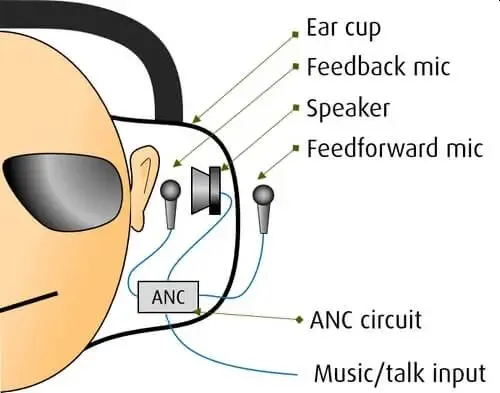
Now that we’ve covered the basics, let’s take a closer look at the anatomy of earbud microphones. It’s like peering into a miniature world of audio engineering!
Size and placement within earbuds
Earbud microphones are incredibly small, often measuring less than a millimeter in size. To put this into perspective, they’re about the size of a grain of sand! This miniaturization is crucial for several reasons:
- Space efficiency: Earbuds need to pack a lot of technology into a very small space. The smaller the microphone, the more room there is for other components like batteries, speakers, and wireless chips.
- Comfort: Smaller components allow for sleeker, more ergonomic earbud designs that can be worn comfortably for long periods.
- Aesthetics: Let’s face it, we want our earbuds to look good. Tiny microphones allow for cleaner, more streamlined designs.
These tiny mics are typically placed in strategic locations on the earbud:
- On the stem (for earbuds with stems): This is common in designs like the Apple AirPods. The stem provides a natural extension towards the mouth, improving voice pickup.
- Near the ear tip: Some designs place the microphone closer to the ear canal. This can provide good voice pickup while being less visible.
- On the outer surface of the earbud: This placement can be good for picking up ambient sound, which is useful for features like active noise cancellation.
The placement is crucial for picking up your voice clearly while minimizing background noise. Some high-end earbuds even have multiple microphones for better sound capture and noise cancellation. For example, a common configuration is to have one microphone facing towards your mouth for voice pickup, and another facing outwards to capture ambient noise for noise cancellation algorithms.
Components of earbud microphones
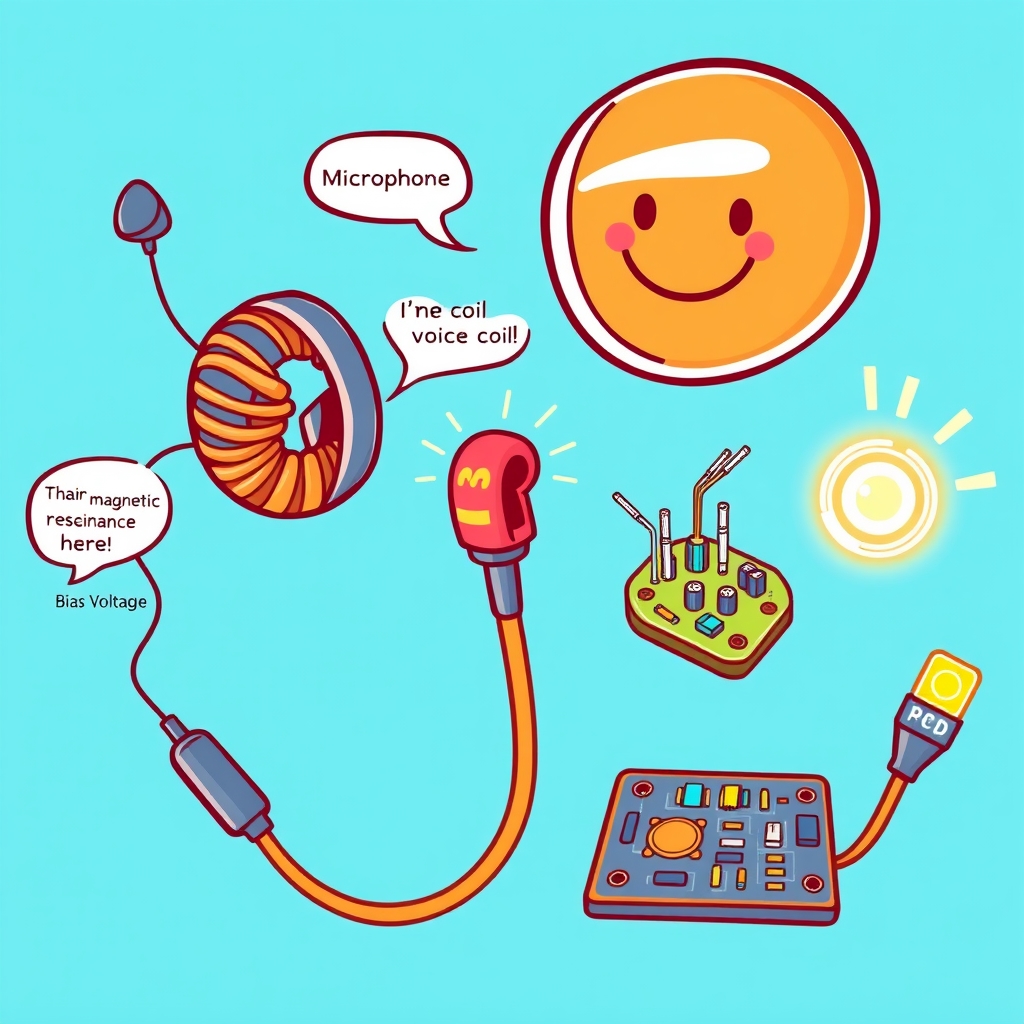
Despite their small size, earbud microphones are made up of several key components. Let’s break them down:
- Diaphragm: This is the heart of the microphone. It’s a thin membrane that vibrates when sound waves hit it. In MEMS microphones, this diaphragm is incredibly tiny and made of silicon. The diaphragm is typically only a few micrometers thick – that’s thinner than a human hair! The diaphragm’s job is to convert acoustic energy (sound waves) into mechanical energy (vibration). The more sensitive the diaphragm, the better it can pick up subtle variations in sound. However, engineers must balance sensitivity with durability – a too-thin diaphragm might pick up sound well but could be easily damaged.
- Backplate: Located behind the diaphragm, the backplate works with the diaphragm to convert sound waves into electrical signals. It’s fixed and doesn’t move. In MEMS microphones, the backplate is typically perforated to allow air to flow through, reducing acoustic damping. The space between the diaphragm and the backplate is crucial. This gap, often only a few micrometers wide, forms a capacitor. As the diaphragm vibrates, the capacitance changes, which is how the microphone converts mechanical energy into electrical signals.
- Housing: This is the outer shell that protects the delicate internal components. In earbuds, the housing needs to be durable and often water-resistant. It’s typically made of hard plastic or metal and is designed to shield the internal components from electromagnetic interference. The housing also includes an acoustic port – a tiny hole that allows sound waves to reach the diaphragm. The design of this port is crucial for the microphone’s performance. It needs to allow sound in while keeping out dust, moisture, and other contaminants.
- ASIC (Application-Specific Integrated Circuit): This is the brain of the microphone. In MEMS microphones, the ASIC is often integrated onto the same chip as the sensor. It handles tasks like amplifying the weak electrical signals from the diaphragm, converting analog signals to digital (in digital MEMS microphones), and sometimes even some basic signal processing.
- Substrate: This is the base on which all the other components are mounted. In MEMS microphones, the substrate is typically silicon, the same material used in computer chips.
Imagine these components working together like a miniature drum kit. The diaphragm is the drumhead, vibrating with each sound. The backplate is like the drum shell, providing structure and helping to capture the vibrations. The housing is the protective case, the ASIC is the sound engineer, and the substrate is the stage on which it all sits.
The manufacturing process
The production of these tiny microphones is a marvel of modern manufacturing. For MEMS microphones, the process is similar to that used in creating computer chips:
- Wafer preparation: The process starts with a silicon wafer – a thin disc of pure silicon.
- Deposition: Layers of various materials are deposited onto the wafer. These might include conductive layers for the backplate and diaphragm, and insulating layers to separate them.
- Photolithography: A light-sensitive material is applied to the wafer, and then exposed to light through a mask. This creates a pattern that defines the structures of the microphone.
- Etching: The wafer is exposed to chemicals or plasma that etches away the exposed areas, creating the intricate structures of the microphone.
- Release: The sacrificial layers are removed, freeing the diaphragm to move.
- Packaging: The individual microphone chips are cut from the wafer and packaged, often with the ASIC in the same package.
This process allows for the creation of thousands of identical microphones on a single wafer, ensuring consistency and keeping costs down.
The result of all this engineering and precision manufacturing? A microphone smaller than a grain of sand, capable of capturing the nuances of human speech and transmitting them across the globe. It’s a testament to human ingenuity and the relentless march of technological progress.
In the next section, we’ll explore how these tiny marvels actually work to capture your voice. Get ready to dive into the physics of sound and the clever engineering that makes it all possible!
IV. How Earbud Microphones Work
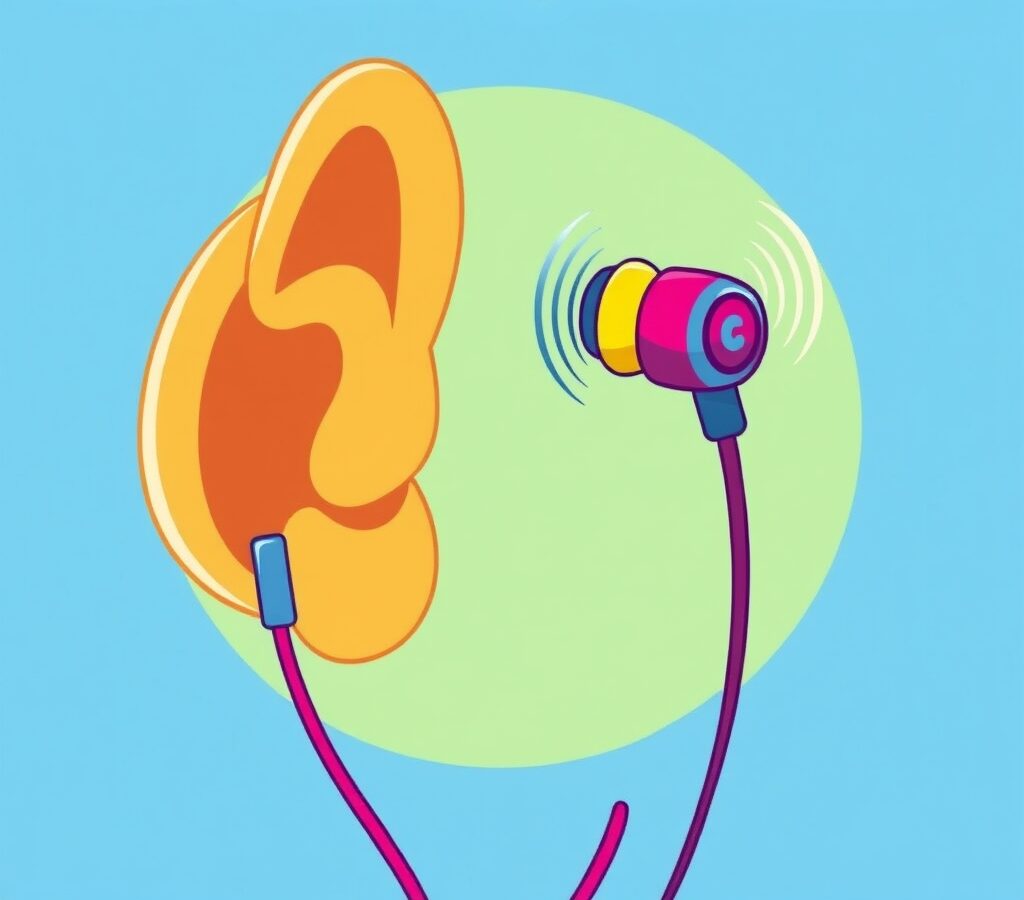
Now that we’ve looked at the parts, let’s see how they all come together to capture your voice. It’s a process that happens in the blink of an eye, transforming sound waves into digital signals your devices can understand.
Sound wave detection
When you speak, your voice creates sound waves that travel through the air. These waves are essentially vibrations in the air molecules. But what exactly are sound waves?
Sound waves are longitudinal waves, meaning the vibrations are in the same direction as the wave’s travel. When you speak, your vocal cords vibrate, causing the air molecules around them to compress and expand. This creates areas of high pressure (compression) and low pressure (rarefaction) that propagate through the air.
These waves travel at about 343 meters per second (at room temperature), which is why there’s often a slight delay when you’re on a video call – the sound has to travel to the microphone, be processed, transmitted, and then played back on the other end.
When these sound waves reach the earbud’s microphone, they cause the diaphragm to vibrate. The diaphragm is so sensitive that it can detect even the tiniest variations in air pressure. In fact, the human ear can detect sound waves that cause the eardrum to vibrate by as little as the diameter of a hydrogen atom!
Think of it like ripples in a pond. Your voice is the stone dropping into the water, and the ripples are the sound waves traveling to the shore (in this case, the microphone). Just as the ripples cause a leaf on the pond’s surface to bob up and down, the sound waves cause the microphone’s diaphragm to vibrate.
Conversion of sound waves to electrical signals
Here’s where the magic happens! As the diaphragm vibrates, it moves closer to and further from the backplate. This movement creates changes in electrical capacitance between the diaphragm and backplate.
In simpler terms, it’s like a game of electric tag. The diaphragm and backplate are playing, and every time they get closer or move apart, they create a tiny electrical signal. This process is called capacitive transduction.
Let’s break it down a bit more:
- The diaphragm and backplate form a capacitor – a device that stores electrical charge.
- When sound waves hit the diaphragm, it moves.
- As the distance between the diaphragm and backplate changes, so does the capacitance.
- This change in capacitance is converted into a change in voltage.
- This voltage change is the electrical signal that represents the sound.
It’s important to note that this electrical signal is very weak – we’re talking about changes measured in microvolts (millionths of a volt). That’s why the next step is so crucial.
Signal processing and amplification
The electrical signals created by the microphone are very weak. They need to be amplified and processed before they can be used. This is done by tiny circuits within the earbud.
These circuits are like personal trainers for the electrical signals, making them stronger and clearer. Here’s what happens:
- Preamplification: The weak signal from the microphone is first boosted by a preamplifier. This increases the signal strength without adding too much noise.
- Analog-to-Digital Conversion (ADC): In digital microphones (which most modern earbuds use), the amplified analog signal is converted into a digital signal. This process samples the analog signal thousands of times per second and converts each sample into a digital value.
- Digital Signal Processing (DSP): Once in digital form, the signal can be processed in various ways:
- Noise reduction algorithms can filter out unwanted background noise.
- Frequency response can be adjusted to enhance voice clarity.
- Echo cancellation can be applied for better call quality.
- Compression: To save bandwidth when transmitting, the digital signal is often compressed. This reduces the amount of data that needs to be sent without significantly impacting sound quality.
These circuits are like personal trainers for the electrical signals, making them stronger and clearer. They also help filter out unwanted noise and enhance your voice.
The role of software
It’s worth noting that a lot of the heavy lifting in modern earbud microphones is done by software. Advanced algorithms can:
- Distinguish between your voice and background noise
- Adjust microphone sensitivity based on the environment
- Apply real-time effects like voice enhancement or modulation
Some high-end earbuds even use machine learning algorithms that can adapt to your voice and your typical usage environments over time, continually improving performance.
V. Microphone Configurations in Earbuds
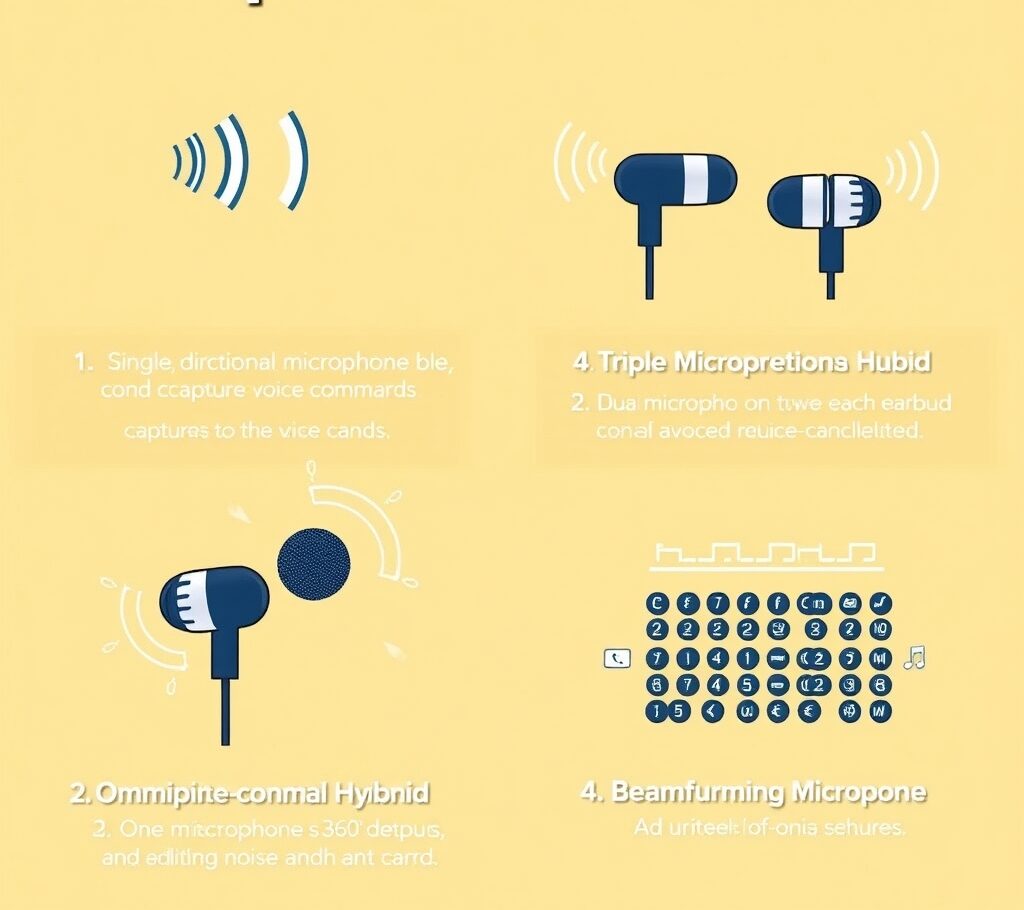
Not all earbuds are created equal when it comes to microphones. Different configurations can significantly impact the quality of your voice capture and noise reduction capabilities.
Single microphone setup
This is the most basic configuration, with one microphone per earbud. It’s like having a single security camera – it does the job, but it might miss some details.
Pros:
- Simple and cost-effective
- Adequate for basic voice calls
- Lower power consumption
Cons:
- Limited noise reduction capabilities
- May struggle in noisy environments
- Less accurate voice detection
Single microphone setups are typically found in budget earbuds or older models. They can work well in quiet environments but may struggle when there’s a lot of background noise.
Dual microphone setup
Many modern earbuds use a dual microphone setup. This configuration uses two mics, often one facing towards your mouth and another facing outwards.
Pros:
- Better noise cancellation
- Improved voice clarity
- Can differentiate between voice and ambient noise
- More effective beamforming capabilities
Cons:
- More complex and slightly more expensive
- Requires more sophisticated signal processing
- Slightly higher power consumption
The dual microphone setup allows for more advanced noise cancellation techniques. By comparing the input from both microphones, the system can better distinguish your voice from background noise.
Quad microphone setup
High-end earbuds sometimes feature a quad microphone setup, with two microphones in each earbud.
Pros:
- Superior noise cancellation
- Excellent voice clarity in various environments
- Can create a more immersive sound experience
- Enables advanced features like 360-degree sound capture
Cons:
- More expensive
- Requires advanced signal processing
- Higher power consumption
- More complex manufacturing process
Quad microphone setups offer the best performance, especially in challenging acoustic environments. They allow for more sophisticated beamforming and noise cancellation algorithms, resulting in clearer voice capture and better call quality.
Comparison of different setups
Let’s break down how these configurations stack up:
| Feature | Single Mic | Dual Mic | Quad Mic |
|---|---|---|---|
| Voice clarity | Good | Better | Best |
| Noise cancellation | Basic | Advanced | Superior |
| Cost | Low | Medium | High |
| Battery impact | Low | Medium | Higher |
| Ideal use case | Quiet environments | General use | Noisy environments |
| Beamforming capability | Limited | Good | Excellent |
| 360-degree sound | No | Limited | Yes |
As you can see, the more microphones, the better the overall performance. But it also comes with increased cost and complexity.
Real-world applications
To put these configurations into perspective, let’s consider some real-world scenarios:
- Busy coffee shop: In this noisy environment, a quad microphone setup would excel. It could use advanced beamforming to focus on your voice while filtering out the chatter and coffee machine noise.
- Quiet office: Here, even a single microphone setup might perform adequately. There’s less background noise to contend with, so the basic noise cancellation would likely suffice.
- Outdoor jog: A dual microphone setup could handle this well. One mic could capture your voice while the other helps cancel out wind noise and passing traffic sounds.
- Conference call: For important business calls, a quad microphone setup would provide the clearest voice quality and the best background noise suppression, ensuring you sound professional regardless of your environment.
The choice of microphone configuration often depends on the intended use case and price point of the earbuds. Budget models aimed at casual users might opt for a single or dual microphone setup, while premium earbuds designed for professionals or audiophiles would likely incorporate a quad microphone system.
VI. Advanced Microphone Technologies in Earbuds

The world of earbud microphones isn’t just about hardware. Software and advanced technologies play a crucial role in enhancing your voice and reducing unwanted noise. Let’s explore some of the cutting-edge technologies that are pushing the boundaries of what’s possible with earbud microphones.
Environmental Noise Cancellation (ENC)
Environmental Noise Cancellation is like having a personal bouncer for your voice. It works to identify and reduce background noise, ensuring that your voice comes through loud and clear.
ENC uses sophisticated algorithms to analyze the incoming sound. It can differentiate between your voice and ambient noise, then selectively reduce the noise while preserving your speech. It’s like magic, but it’s actually clever math and signal processing!
Here’s how ENC typically works:
- Sound analysis: The system analyzes the incoming audio in real-time, breaking it down into different frequency components.
- Voice detection: Advanced algorithms identify the characteristics of human speech, separating your voice from background noise.
- Noise profiling: The system creates a profile of the background noise, identifying consistent sounds that aren’t your voice.
- Adaptive filtering: Based on the noise profile, the system applies filters to reduce or eliminate the identified background noise.
- Voice enhancement: While reducing background noise, the system may also enhance the frequencies associated with your voice, making it clearer and more intelligible.
ENC can be particularly effective in dealing with steady background noises like the hum of an air conditioner, the rumble of traffic, or the chatter in a busy office.
Beamforming technology
Beamforming is a technique that uses multiple microphones to focus on sound coming from a specific direction – in this case, your mouth. It’s like having a spotlight that follows your voice, making sure it’s always in the limelight.
Here’s how it works:
- The microphones capture sound from all directions.
- The system calculates the slight differences in when the sound reaches each mic.
- It uses these differences to determine the direction of your voice.
- The system then enhances sounds from that direction while suppressing others.
Beamforming can significantly improve voice clarity, especially in noisy environments. It’s like having a superpower that lets you cut through the noise!
Some advanced beamforming systems can even track your voice as you move, continuously adjusting to ensure optimal voice pickup. This is particularly useful for earbuds used during exercise or other activities where you’re not staying still.
AI-enhanced noise reduction
Artificial Intelligence is making its way into earbud technology, and it’s revolutionizing how we handle noise. AI-enhanced noise reduction goes beyond traditional methods by learning and adapting to different types of noise.
Imagine you’re walking down a busy street. Traditional noise reduction might struggle to differentiate between your voice and the various street sounds. But an AI system can learn to recognize different types of noise – traffic, wind, chatter – and selectively filter them out.
Here are some ways AI is enhancing noise reduction in earbuds:
- Adaptive noise profiling: AI systems can create and continuously update noise profiles based on your environment, allowing for more effective noise cancellation.
- Voice recognition: Some AI systems can recognize and enhance specific voices, making sure that your voice (and not your friend’s) comes through clearly on a call.
- Contextual awareness: Advanced AI can understand the context of your environment and adjust noise reduction strategies accordingly. For example, it might use different algorithms for a noisy restaurant versus a windy outdoor setting.
- Learning and improvement: Some AI systems in high-end earbuds can learn from your usage patterns over time, continually improving their performance.
Bone conduction technology
While not strictly a microphone technology, bone conduction is worth mentioning as an innovative way to capture voice in earbuds. This technology uses sensors that pick up vibrations directly from your skull, bypassing air-conducted sound altogether.
Bone conduction has several advantages:
- It’s less affected by environmental noise
- It can work well in wet conditions where traditional microphones might struggle
- It can provide clearer voice capture in very loud environments
However, bone conduction technology in earbuds is still in its early stages and is not yet widely implemented.
Multi-channel audio processing
Some advanced earbuds use multi-channel audio processing to create a more immersive sound experience. This technology can be used not just for playback, but also for recording.
For example, earbuds with multiple microphones can capture spatial audio, preserving the directional information of sounds. This can be useful for creating more realistic audio recordings or for enhancing the accuracy of voice commands in AR/VR applications.
As these technologies continue to evolve, we can expect even more impressive capabilities from our tiny earbud microphones. The future might bring us earbuds that can isolate a single voice in a crowded room with perfect clarity, or perhaps even translate languages in real-time. The possibilities are truly exciting!
VII. The Role of Microphones in Earbud Features

Microphones in earbuds do more than just capture your voice for calls. They’re integral to many features that make modern earbuds so versatile and user-friendly. Let’s explore the various roles these tiny mics play in enhancing your audio experience.
Voice calls and audio recording
This is the most obvious use of earbud microphones. Whether you’re making a quick call to your mom or recording a voice memo, the microphone is your direct line of communication.
The quality of these calls and recordings depends on various factors:
- Microphone sensitivity
- Noise cancellation capabilities
- Signal processing algorithms
High-end earbuds often provide near studio-quality voice capture, making them great for podcasters or vloggers on the go. Some even offer multi-microphone recording capabilities, allowing for stereo or spatial audio capture.
For voice calls, the microphone works in tandem with noise reduction technologies to ensure your voice comes through clearly, even in noisy environments. Many earbuds now offer features like:
- Wind noise reduction: Algorithms that detect and minimize wind noise, which can be particularly problematic for outdoor calls.
- Voice focus: Technology that emphasizes the frequency range of human speech while de-emphasizing other sounds.
- Echo cancellation: Algorithms that prevent the sound from the earbud speakers from being picked up by the microphone, which could cause echo or feedback.
Active Noise Cancellation (ANC)
While primarily associated with the speakers in earbuds, Active Noise Cancellation actually relies heavily on the microphones too. Here’s how it works:
- The external microphones pick up ambient noise.
- The ANC system analyzes this noise and creates an “anti-noise” signal.
- This anti-noise is played through the earbud speakers, canceling out the external noise.
It’s like the microphones and speakers are working together to create a bubble of silence around your ears. Pretty cool, right?
The effectiveness of ANC depends greatly on the quality and placement of the microphones. This is one reason why many high-end earbuds have multiple microphones – some dedicated to voice pickup, others to ambient noise detection for ANC.
Some advanced ANC systems even use internal microphones (placed inside the ear canal) to fine-tune the noise cancellation, adapting to the unique shape of each user’s ear.
Voice assistant activation
“Hey Siri” or “OK Google” – these phrases have become part of our daily lives, and earbud microphones make them possible on the go. The microphones are always listening for these wake words, ready to activate your voice assistant.
This feature requires the microphones to be in a low-power listening mode constantly, which presents challenges for battery life. To address this, many earbuds use specialized low-power processors dedicated to wake word detection.
Some advanced earbuds use AI to recognize your voice specifically, adding an extra layer of security and preventing accidental activations. This technology, often called voice print or voice ID, creates a unique profile of your voice, ensuring that only you can activate the voice assistant through your earbuds.
Transparency mode
Many modern earbuds offer a transparency mode (also called ambient mode or hear-through mode). This feature uses the earbud microphones to pick up external sounds and play them through the earbud speakers, allowing you to hear your surroundings without removing your earbuds.
Transparency mode can be particularly useful in situations like:
- Having a quick conversation without removing your earbuds
- Staying aware of your surroundings while running or cycling
- Hearing announcements in public transport
Some advanced implementations of transparency mode even allow for selective sound amplification. For example, you might be able to enhance human voices while still blocking out other ambient noises.
Adaptive EQ
Some high-end earbuds use their microphones to implement adaptive EQ (equalization). Here’s how it works:
- Tiny microphones inside the ear canal measure the sound as it’s played back.
- The system analyzes this sound in real-time.
- It adjusts the EQ to compensate for factors like the shape of your ear canal or the fit of the earbud.
This results in a personalized sound that’s optimized for your unique ear shape and how you’re wearing the earbuds.
Health and fitness features
Believe it or not, the microphones in your earbuds can even play a role in health and fitness features. Some examples include:
- Breathing detection: By picking up the sound of your breathing, earbuds can help guide meditation exercises or monitor exertion during workouts.
- Eating detection: Some experimental systems use the sounds picked up by earbud microphones to detect and log eating habits.
- Heart rate detection: While most earbuds use optical sensors for this, some systems can detect heart rate through the subtle sounds it produces, picked up by very sensitive microphones.
As technology continues to advance, we’re likely to see even more innovative uses for the microphones in our earbuds. From real-time translation to health monitoring, the possibilities are exciting and vast.
The microphone is truly the unsung hero of modern earbuds, enabling a wide range of features that go far beyond simple voice calls. As we continue to demand more from our personal audio devices, you can bet that microphone technology will be at the forefront of innovation, constantly pushing the boundaries of what’s possible in such a small package.
VIII. Challenges and Innovations in Earbud Microphone Design

Creating high-quality microphones for earbuds is no easy feat. Engineers face several challenges, but they’re constantly innovating to overcome them. Let’s explore some of these challenges and the innovative solutions being developed.
Miniaturization
The biggest challenge is making microphones small enough to fit in earbuds without compromising on quality. It’s like trying to fit all the power of a professional recording studio into something smaller than a pea!
Challenges:
- Maintaining sensitivity in a smaller package
- Ensuring durability of tiny components
- Managing heat in a confined space
Innovations:
- Advanced MEMS technology: Manufacturers can now create microphones that are less than a millimeter in size but still offer excellent sound quality. These use sophisticated microfabrication techniques similar to those used in computer chip production.
- 3D integration: Some manufacturers are exploring 3D integration techniques, stacking components vertically to save space while maintaining performance.
- Piezoelectric MEMS: This emerging technology uses piezoelectric materials that generate electrical charges when stressed, potentially allowing for even smaller and more sensitive microphones.
Power efficiency
Earbuds run on tiny batteries, so every component needs to be as power-efficient as possible. Microphone designers are constantly working to reduce power consumption without sacrificing performance.
Challenges:
- Maintaining performance with lower power
- Managing always-on features like voice assistant activation
- Balancing power needs with other earbud components
Innovations:
- Low-power MEMS designs: New MEMS microphone designs focus on reducing power consumption, with some models using as little as 20µA of current.
- Smart power management systems: These activate microphones only when needed, conserving power during idle periods.
- Efficient signal processing algorithms: Advanced algorithms can process audio with less computational power, reducing overall energy consumption.
- Energy harvesting: Some experimental designs are exploring ways to harvest energy from sound vibrations or body heat to supplement battery power.
Durability and water resistance
Earbuds lead tough lives. They’re exposed to sweat, rain, and sometimes even an accidental trip through the washing machine. Designing microphones that can withstand these conditions is crucial.
Challenges:
- Protecting delicate components from moisture and dust
- Maintaining acoustic performance with protective measures
- Ensuring long-term reliability in varied environments
Innovations:
- Nano-coatings: Many modern earbuds feature hydrophobic nano-coatings that repel water and sweat, protecting the delicate microphone components.
- Improved sealing techniques: Advanced sealing methods help create a barrier against moisture and dust without impeding sound transmission.
- Acoustic mesh: Special water-resistant acoustic mesh materials allow sound to pass through while blocking liquids and particulates.
- Self-cleaning mechanisms: Some high-end earbuds incorporate tiny vibration mechanisms that can shake off water droplets or dislodge debris from microphone ports.
Noise handling
Dealing with unwanted noise is a significant challenge for earbud microphones, especially given their small size and proximity to other electronic components.
Challenges:
- Differentiating between voice and ambient noise
- Handling wind noise during outdoor use
- Managing electronic noise from other earbud components
Innovations:
- Multi-microphone arrays: Using multiple microphones allows for advanced noise cancellation and beamforming techniques.
- AI-powered noise reduction: Machine learning algorithms can adapt to different noise environments and even learn user preferences over time.
- Acoustic design optimization: Careful design of the earbud shell and microphone placement can naturally reduce certain types of noise.
- Wind noise reduction algorithms: Specialized software can detect and minimize wind noise, which is particularly challenging for small microphones.
Integration with other components
Earbuds are complex devices with many components packed into a tiny space. Integrating the microphone effectively with other parts is a significant challenge.
Challenges:
- Avoiding electromagnetic interference from other components
- Managing heat in a confined space
- Coordinating microphone function with speakers and processors
Innovations:
- System-on-Chip (SoC) designs: Integrating microphone, processor, and other components on a single chip can improve efficiency and reduce interference.
- Shielding techniques: Advanced electromagnetic shielding methods help protect the sensitive microphone circuitry from interference.
- Thermal management solutions: Innovative heat-spreading materials and designs help manage temperature in the confined earbud space.
- Unified firmware: Sophisticated firmware coordinates the function of all earbud components, ensuring smooth integration of the microphone with other features.
Future directions
As technology continues to advance, we can expect to see even more innovations in earbud microphone design:
- Graphene microphones: This super-thin and strong material could revolutionize microphone design, allowing for even smaller and more sensitive mics.
- Optical microphones: Using light to detect sound vibrations could offer new levels of sensitivity and noise immunity.
- AI-on-chip: Integrating AI processors directly with microphone hardware could enable more sophisticated real-time audio processing.
- Biometric sensors: Future microphones might double as health sensors, detecting vital signs or even early signs of illness through voice analysis.
These challenges and innovations highlight the incredible engineering that goes into the tiny microphones in our earbuds. As consumers demand ever-better audio quality, longer battery life, and more features from their earbuds, you can be sure that microphone technology will continue to evolve and improve. The future of earbud microphones is an exciting field, full of potential for groundbreaking advancements that will enhance our audio experiences in ways we might not yet imagine.
IX. The Future of Earbud Microphone Technology

As we look to the horizon, the future of earbud microphone technology is brimming with exciting possibilities. Emerging trends and potential advancements promise to revolutionize how we interact with our devices and the world around us. Let’s explore what the future might hold for these tiny yet powerful components.
Emerging trends
- Biometric sensors: Some companies are exploring ways to integrate health monitoring sensors into earbud microphones. Imagine earbuds that can check your temperature, monitor your breathing rate, or even detect early signs of illness through voice analysis. These “hearables” could become an integral part of personal health monitoring.
- Spatial audio recording: As spatial audio becomes more popular for playback, we might see earbuds that can record in 3D audio, capturing sound from all around you. This could be particularly useful for content creators, allowing them to capture immersive audio on the go.
- Enhanced AI integration: Future microphones might use AI not just for noise cancellation, but for real-time translation, voice changing, or even health anomaly detection based on voice patterns. The integration of more powerful AI chips directly into earbuds could enable sophisticated processing right at the source.
- Augmented hearing: Advanced microphone and speaker combinations could enhance human hearing capabilities. This could range from subtle enhancements like better speech recognition in noisy environments to more dramatic augmentations that extend the range of frequencies we can hear.
- Adaptive acoustics: Future earbuds might use their microphones to analyze the acoustic properties of your environment and adjust their output accordingly, ensuring optimal sound quality whether you’re in a small room or a large auditorium.
Potential advancements
- Graphene microphones: Graphene, a super-thin and strong material, could revolutionize microphone design. Graphene-based microphones could be incredibly thin and flexible while offering superior sensitivity and frequency response. This could lead to earbuds that are even smaller and more comfortable, with unparalleled audio quality.
- Bone conduction microphones: These could pick up your voice directly through the vibrations in your skull, potentially offering crystal-clear voice capture even in the noisiest environments. This technology could be particularly useful for sports earbuds or in industrial settings where ambient noise is a significant issue.
- Self-cleaning microphones: Nano-coatings or tiny vibration mechanisms could help keep microphone ports clear of debris, ensuring consistent performance over time. This could significantly extend the lifespan of earbuds and maintain audio quality even with heavy use.
- Energy harvesting microphones: Imagine microphones that can generate their own power from sound vibrations or even from the heat of your body. This could significantly extend battery life or even lead to earbuds that never need charging.
- Quantum sensors: While still in the realm of theoretical research, quantum sensors could potentially offer unprecedented sensitivity in detecting sound waves, potentially revolutionizing the capabilities of earbud microphones.
- Neural interfaces: In the more distant future, we might see earbuds that can interpret neural signals, allowing for thought-based control or even direct brain-to-brain communication. While this technology is still in its infancy, it represents an exciting potential direction for personal audio devices.
Implications and challenges
These advancements, while exciting, also come with their own set of challenges and implications:
- Privacy concerns: As earbuds become more capable of monitoring our health and environment, questions of data privacy and security will become increasingly important.
- Regulatory hurdles: Advanced health monitoring features might require approval from health regulatory bodies, potentially slowing down innovation in this area.
- User adaptation: Some advanced features might require users to learn new ways of interacting with their devices, which could present adoption challenges.
- Ethical considerations: Technologies like real-time translation or augmented hearing capabilities could have profound societal impacts that will need to be carefully considered.
- Technical challenges: Many of these advanced features will require significant improvements in battery technology, signal processing capabilities, and materials science.
The role of user experience
As earbud microphone technology advances, user experience will play a crucial role in determining which innovations succeed in the market. Features that seamlessly integrate into users’ lives and provide clear benefits are likely to see widespread adoption.
For example, health monitoring features that provide actionable insights without requiring constant user interaction could be particularly successful. Similarly, augmented hearing capabilities that naturally enhance the listening experience without feeling intrusive could find broad appeal.
Integration with other technologies
The future of earbud microphones is likely to be closely tied to advancements in other areas of technology:
- 5G and beyond: As wireless networks become faster and more reliable, earbuds could offload more processing to the cloud, enabling more sophisticated features.
- Augmented Reality (AR): Earbuds could play a crucial role in AR systems, providing spatial audio and voice control for immersive experiences.
- Internet of Things (IoT): Earbuds could become central hubs for controlling and interacting with various IoT devices through voice commands and audio cues.
- Artificial Intelligence: Advances in AI will likely drive many of the sophisticated processing capabilities we’ve discussed, from real-time translation to health monitoring.
X. Conclusion
As we’ve journeyed through the fascinating world of earbud microphones, from the basics of how they work to the cutting-edge technologies that are pushing the boundaries of what’s possible, it’s clear that these tiny marvels of engineering play a crucial role in our daily communications, and they’re only getting better.
We’ve explored the intricate anatomy of these miniature mics, delved into the physics of sound capture, and marveled at the advanced signal processing that turns air vibrations into crystal-clear digital signals. We’ve seen how different microphone configurations can dramatically impact performance, and how software plays an increasingly important role in enhancing our audio experiences.
The challenges faced by engineers in this field are formidable – from miniaturization and power efficiency to durability and noise handling. Yet, time and again, innovative solutions emerge, driving the technology forward and enabling new features and capabilities.
Looking to the future, the potential advancements in earbud microphone technology are truly exciting. From health monitoring and spatial audio recording to augmented hearing and even neural interfaces, the possibilities seem limitless. These advancements promise not just to improve the quality of our audio experiences, but to fundamentally change how we interact with our devices and the world around us.
The next time you pop in your earbuds for a call, take a moment to appreciate the incredible technology working hard to capture your voice. From the vibrating diaphragm to the AI-powered noise cancellation, every part works in harmony to keep you connected.
As technology continues to advance, who knows what amazing features future earbud microphones might bring? One thing’s for sure – these little devices will keep playing a big role in how we interact with our increasingly connected world.
So, the next time someone asks you, “How does the microphone on earbuds work?” you can confidently say, “Well, let me tell you about these amazing little devices…” And who knows? By then, you might be explaining how your earbuds just alerted you to an upcoming cold, translated a conversation in real-time, or helped you hear a whisper from across a noisy room.
The world of earbud microphones is a testament to human ingenuity and the relentless march of technological progress. It’s a world where the minuscule enables the mighty, where vibrations become conversations, and where the future of communication is always just a whisper away.

